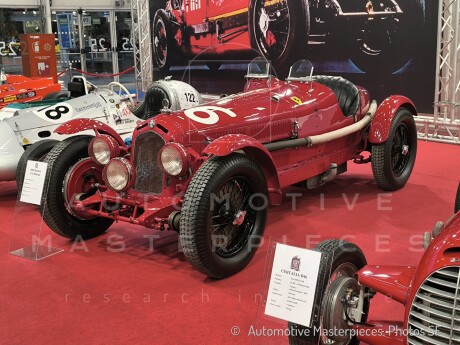
#AlfaRomeo8C2300
The Alfa Romeo 8C name was used on road, race and sports cars of the 1930s. The 8C means 8 cylinders, and originally referred to a straight 8-cylinder engine. The Alfa Romeo 8C 2300 was designed by Vittorio Jano, who was already the creator of the Alfa Romeo 6C 1750 sports car. The 8C 2300 was built between 1931 and 1933.
The engineer joined Alfa Romeo in in 1923, and immediately initiated the design of a new twin overhead cam grand prix car, the P2, which won the French and Italian GPs in 1924 and the Belgian and Italian GPs in 1925.
He was also responsible for the use of twin-cam engines in two series of the 6C cars. Alfa wanted to return to GP racing and Jano designed the 8C2300 in three forms which competed in long chassis (Le Mans form with the obligatory rear seat), short chassis (Mille Miglia form) and the ultra short chassis two seater racing car, the Monza.
The dimensions of the 8C are identical to those of the 6C from which it is derived. The Alfa 8C-2300 was raced initially by the factory but later by many private entrants and teams, the most notable of the latter being including Scuderia Ferrari. The first model was the 1931 '8C 2300', a reference to the car's 2.3 L (2336 cc) engine, initially designed as a racing car, but actually produced in 188 units also for road use. While the racing version of the 8C 2300 Spider, driven by Tazio Nuvolari won the 1931 and 1932 Targa Florio race in Sicily, the 1931 Italian Grand Prix victory at Monza gave the "Monza" name to the twin seater GP car, a shortened version of the Spider. The first long chassis Le Mans were built for 1931. The history of these long-chassis Le Mans cars shows that they dominated long-distance racing, winning at Le Mans in 1931, 1932, 1933, 1934, and almost 1935 (were not for a technicality according to some observers). Their speed, reliability, and strength led to their great performances in these races as well as the fact that several would appear in each race. The Alfa Romeo factory often added the name of events won to the name of a car. The engine fitted in the Alfa 8C-2300 was initially 2.3 litres but increased in 1934 to 2.6. Power from the straight eight, twin overhead cam unit with alloy block and cylinder head rose to over 170 hp. The 8C 2300 had the same bore and stroke dimensions of the six, but the timing and blower drive gears were mounted between two light allow blocks - basically two four-cylinder engines set back to back. A Roots-type supercharger was installed on the right side of the engine block. A four speed manual gearbox and drum brakes were also used. The competition career of the Alfa Romeo 8C is littered with wins and illustrious drivers. Due to financial difficulties Alfa Romeo stopped racing in 1933 (Alfa's own version of the story is that the marque had already proved itself) and sold off its racing division to Enzo Ferrari, who established his own racing team, Scuderia Ferrari.
We'll tell the story of this model on the occasion of its anniversary or when it will reach a sufficient number of cars.
If you would like to share your knowledge and archive, click on the banner JOIN THE LAB - HELP US TO IMPROVE & COMPLETE THE INFORMATION.
The census of all the cars related to this topic is in progress.
CARS (1)
